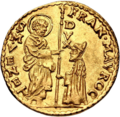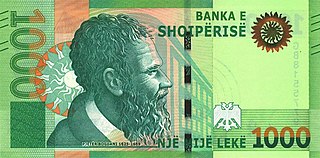
The lek is the currency of Albania. Historically, it was subdivided into 100 qintars.

The lira was the currency of Italy between 1861 and 2002. It was introduced by the Napoleonic Kingdom of Italy in 1807 at par with the French franc, and was subsequently adopted by the different states that would eventually form the Kingdom of Italy in 1861. It was subdivided into 100 centesimi, which means "hundredths" or "cents". The lira was also the currency of the Albanian Kingdom from 1941 to 1943.
The lira austriaca was the currency of the Kingdom of Lombardy–Venetia.
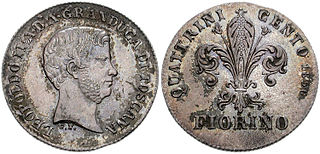
The Tuscan fiorino was the currency of Tuscany between 1826 and 1859. It was subdivided into 100 quattrini, a local currency made by four denari. There was an additional denomination called the paolo, worth 40 quattrini, in circulation.

The Roman scudo was the currency of the Papal States until 1866. It was subdivided into 100 baiocchi, each of 5 quattrini. Other denominations included the grosso of 5 baiocchi, the carlino of 7+1⁄2 baiocchi, the giulio and paoli both of 10 baiocchi, the testone of 30 baiocchi and the doppia of 3 scudi.

The lira was the currency of the Papal States between 1866 and 1870. It was subdivided into 20 soldi, each of 5 centesimi.
The lira was the distinct currency of Venice until 1848, when it was replaced by the Italian lira. It originated from the Carolingian monetary system used in much of Western Europe since the 8th century CE, with the lira subdivided into 20 soldi, each of 12 denari.
The scudo was the currency of Milan until 1806. It was subdivided into 6 lire, each of 20 soldi or 240 denari.
The lira was the currency of the Republic of Lucca until 1800 and again of the Duchy of Lucca between 1826 and 1847. It was subdivided into 20 soldi, each of 3 quattrini or 12 denari.
The lira was the currency of the mainland part of the Kingdom of the Two Sicilies, known as the Kingdom of Naples, between 1812 and 1813.
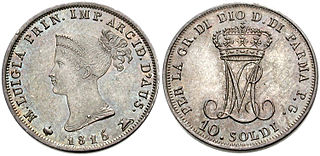
The lira was the distinct currency of Parma before 1802 and again from 1815 to 1859.

Cagliarese or callaresito is the name of a series of coins minted at Cagliari (Sardinia).
The scudo was the currency of the island Kingdom of Sardinia until 1816.

The scudo was the currency of the Piedmont and the other mainland parts of the Savoyard Kingdom of Sardinia until 1816.
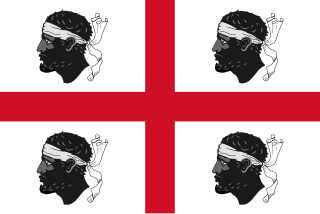
The Kingdom of Sardinia, also referred to as the Kingdom ofSardinia-Piedmont or Piedmont-Sardinia as a composite state during the Savoyard period, was a country in Southern Europe from the late 13th until the mid-19th century.

Italy has a long history of different coinage types, which spans thousands of years. Italy has been influential at a coinage point of view: the medieval Florentine florin, one of the most used coinage types in European history and one of the most important coins in Western history, was struck in Florence in the 13th century, while the Venetian sequin, minted from 1284 to 1797, was the most prestigious gold coin in circulation in the commercial centers of the Mediterranean Sea.
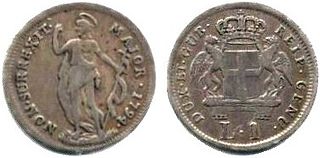
The Genoese lira was the currency of the Republic of Genoa until 1797.

The Kingdom of Sardinia is a term used to denote the Savoyard state from 1720 until 1861, which united the island of Sardinia with the mainland possessions of the House of Savoy. Before 1847, only the island of Sardinia proper was part of the Kingdom of Sardinia, while the other mainland possessions were held by the Savoys in their own right, hence forming a composite monarchy and a personal union which was formally referred to as the "States of His Majesty the King of Sardinia". This situation was changed by the Perfect Fusion act of 1847, which created a unitary kingdom. Due to the fact that Piedmont was the seat of power and prominent part of the entity, the state is also referred to as Sardinia-Piedmont or Piedmont-Sardinia and sometimes erroneously as the Kingdom of Piedmont.

The 1 lira cent, commonly called centesimino, was the smallest denomination of Italian lira coins. Like the contemporary 2, 5 and 10 cent coins, it was made of a bronze alloy composed of 960‰ copper and 40‰ tin. The 1-cent coins were minted between 1861 and 1918, only to be withdrawn from circulation in 1924.















